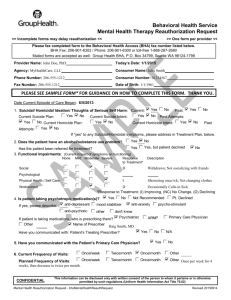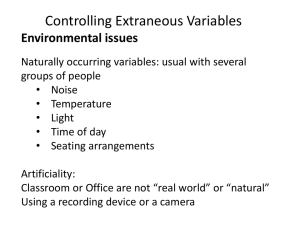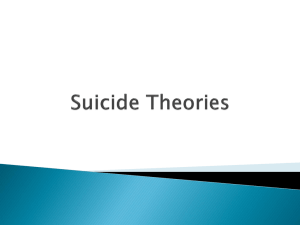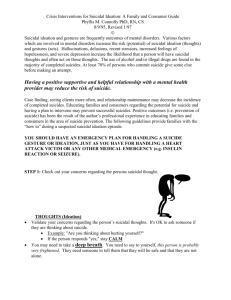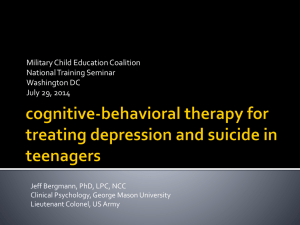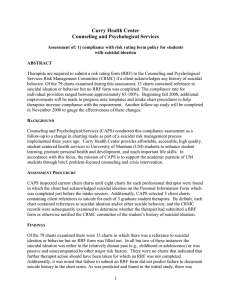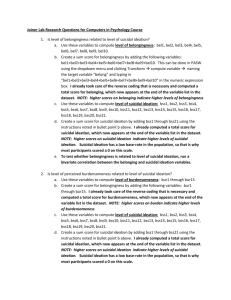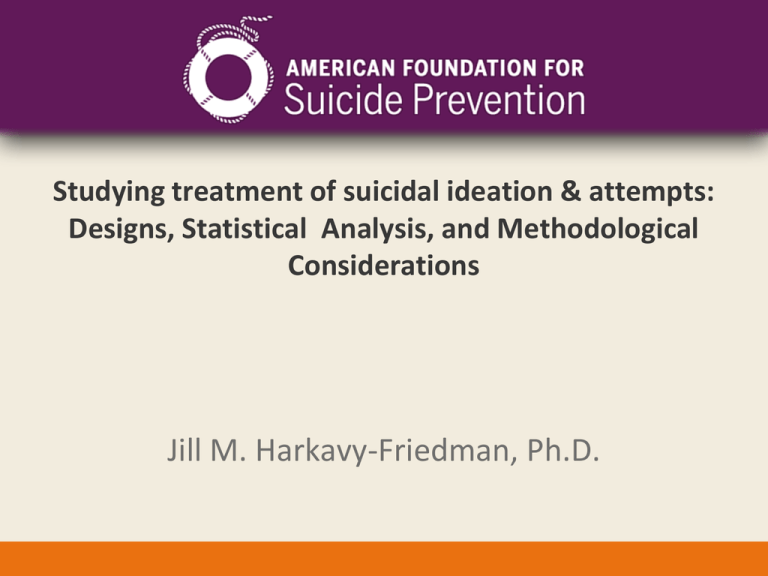
Studying treatment of suicidal ideation & attempts:
Designs, Statistical Analysis, and Methodological
Considerations
Jill M. Harkavy-Friedman, Ph.D.
Objective: To review the design and methodological
factors that impact the study of interventions for
suicidal ideation and attempts
Includes
Evaluate the impact of the intervention
Evaluate the intervention itself
Review of design
considerations:
Goals
Design
Sample
Measures
Procedures
Data Analysis
Treatment Evaluation
Goals
Theory/ Rationale
Meaningful
Testable hypotheses
Feasible
Design considerations
Type of design
Questions that can be answered
Questions that cannot be answered
Multi-method multi-trait approach
Strengths and Limitations
Types of Design:
Pre-post
Control/Comparison Group
Randomized, stratified random, convenience
Longitudinal
Prospective cohort design
Epidemiological
Large scale cohort or case-control
Sample Considerations
Who is the target of the intervention?
Patients
All patients
At-risk
Attempters, ideators
How is the sample selected?
Identification of Sample:
Convenience vs. Random
Criteria for inclusion and exclusion:
Recruitment and Screening
Demographic considerations:
Age, sex, educational level
Determination of Control or Comparison
Group
How will the nature of the sample
affect measurement and
procedures?
Attainment of necessary sample size
Developmental level and language level
Potential burden/ load for participant
Representativeness and generalizability
Feasibility
Time, place, implementation, ability of
participants, attrition
What needs to be measured?
Outcome
Confounders
Mediators and Moderators
Context
Administration Considerations
Format
Face-to-face interview, self-report, telephone,
computer
Source of information
Self, other informant, records, epidemiological
information
Instrument for repeated measures
Same form, alternate forms
Outcome Measures Must:
Measure the target of intervention
Be standardized
Be expected to change within the time frame
Be Sensitive to change
Be present in all groups
Have a measurable effect size
Have demonstrated reliability and validity
Be feasible
Current Measures of Outcome
Suicidal Ideation
Suicide Attempts
Completed Suicide
Lethality of attempt
# crisis calls
Associated symptoms
Adjunctive medications
Hospitalization
# referrals
Social Skills
Procedural Considerations
Intervention
Definition and manualization
# sessions, length, medication dose
Expected outcomes relevant & measurable
Training & ongoing supervision
Maintenance of blind assessors
Implementation of intervention and fidelity
Adherence and attrition
Interval of Measurement
One-shot, short-term, long-term
Recruitment Methods
Systematic, documented
Keeping people in the program
Investigator’s Role
Avoid potential biases
Appropriate level of supervision
Ethical Considerations
Confidentiality, identification of risk, intervention
Feasibility
Data Analysis
Goals
Efficacy/ Impact of Intervention
Program Evaluation
Considerations before conducting
the study that impact data analysis:
Specific, testable hypotheses with data analytic
strategy established
Power Analysis
Potential confounders, mediators & moderators
Type and nature of data
Number of analyses
Effect sizes and variability of measures
Data reduction
Managing and imputing missing data
Types of Analyses
Univariate
T-tests, chi-square, ANOVA, Correlation,
nonparametric
Multivariate
Repeated Measures
Path Analysis
Multiple Regression techniques
Survival Analysis
Time series or trend analysis
Points to consider when
analyzing:
Know your data before any analyses
Reliability is the upper limit of validity
No variability means no finding
Not everything is linear
Build models based on univariate statistics- test
with multivariate
The analysis must fit the type of data
With numerical data, continuous variables are
more informative than categorical variables
Evaluating an intervention
Feasibility
Fidelity to intervention
Reliability and validity of all measures
Attrition
Adherence
Consumer satisfaction
Negative Outcomes/ Adverse Events
Feasibility of the intervention
Time
Resources: staff, space, money, supplies
Availability of participants
Setting interest and amenability
Implementation of intervention
Assessment methods
Fidelity to Intervention
Evaluation of training
Ongoing training and reliability
Ongoing monitoring of intervention
Staff efficacy and satisfaction
Attrition
Assess from recruitment to end of study
Compare rate of attrition to typical rates
Compare drop-outs to study completers on
baseline, demographic and relevant variables
Reliability and Validity of
Measures
Assess all measures with all appropriate forms
of reliability
Test discriminant and convergent validity
Adherence
Embed measures of adherence in intervention
and assessments
Attendance
Questions about previous sessions
Test for medication or substances
Follow-up behavioral questions
Consumer Satisfaction
Participants
Staff
Outside Informants
family members, service providers
Monitor Negative/ Adverse
Events
Document adverse events in a standard
manner
Anticipate potential adverse events and
prepare assessment and monitoring tools
Plan for suicidal risk
Special considerations for
suicide research
Need enough suicidal behavior to notice a
difference
When is an intervention effective
Reduction vs. Elimination
Monitoring for safety in an potentially unsafe
sample
Decision about when a participant is exited from
the study
Intervention regarding suicidal behavior is an
intervention that effects outcome behavior
Conclusion
Many decisions to be made when designing a
study
Each decision affects the conduct of the study
Method determines the conclusions that can
be drawn from any one study
Validity is accrued across studies


